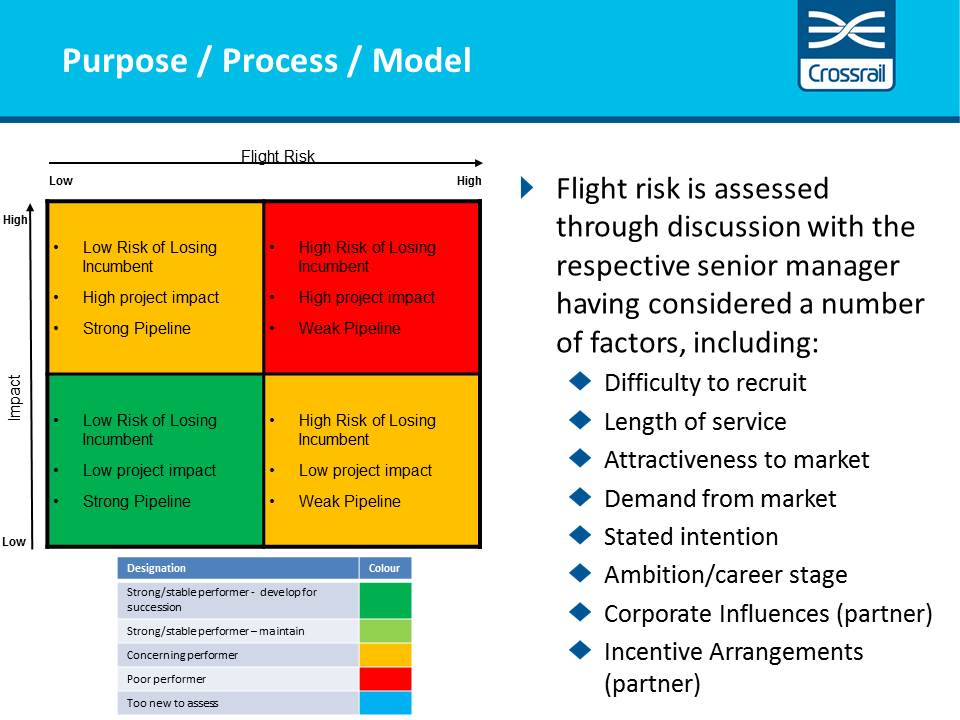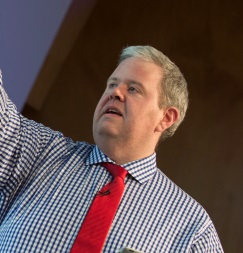
Talent & Succession Planning
Document
type: Micro-report
Author:
Rob Jones
Publication
Date: 27/09/2016
-
Abstract
This micro-report provides an overview of Crossrail’s approach to talent & succession planning which is targeted at increasing organisational resilience, understanding the organisational‘bench-strength’ and increasing the availability of experienced and capable people that are prepared to assume roles as they become available.
This micro-report will be of interest to individuals who seek to embed a talent and succession planning process in their organisation such as senior leadership team; human resource directors; human resource business partners; organisational development practitioners
-
Read the full document
Context
Crossrail formed an integrated client delivery organisation in 2011 forming a singular entity charged with delivering the Crossrail programme. The integrated team was formed from employees of Crossrail Limited, the Project Delivery Partner (a joint venture of three organisations) and the Programme Partner (a joint venture of five organisations) with the aim of improving efficiency and team alignment across the project. .
With the opportunities and risks of delivery now vested in this single, integrated team it was necessary to formalise succession planning arrangements. The aim was to:
- ensure sufficient resilience of the organisation;
- understand both leadership and technical capability; and
- determine how best to approach retaining key individuals.
People Strategy
The Crossrail People Strategy identified that talent and succession management was a risk that needed to be effectively managed. The People strategy recommended implementing a talent management programme and succession planning processes, including gaining assurances from Partner organisations to reduce the risks associated with key people leaving the project. This is detailed in the People Strategy Case Study.
Definitions
To ensure there was a clear understanding of how the tools being developed worked together, Crossrail operated with the following definitions:
- Succession Planning — focused on organisational resilience and the ability for the organisation to continue to deliver its objective if key roles were not filled
- Talent Planning — focused on people and the risk around key individuals and the impact that their departure would have on project delivery
For the purposes of succession planning the target levels were defined as the Executive Committee and the two levels of hierarchy reporting to the Executive.
Challenges
The first challenge of developing a robust succession plan was in aligning all of the Partners to ensure Crossrail received the best information on talent and succession, recognising that the continuing effectiveness of the integrated team was as dependant on succession for roles staffed by partner colleagues as those staffed by employees of Crossrail Limited.
Recognising that Crossrail’s Partners had broader challenges for retaining staff provided by other client commitments and the aspirations of their staff was key in supporting a dialogue that was open and transparent with regards to staff currently assigned to the Crossrail programme.
The second challenge was the result of a conscious decision to create an organisation as flat as possible. This meant that there we no senior people ‘in waiting’ for succession.
The final major challenge was around demonstration of value for the time and effort invested in completing both the succession and talent plan. Recognising Crossrail as a ‘fixed term’ organisation, it was important to work with leaders to help them recognise the value in understanding the risks and mitigations and responses available. This ensured that leaders had a deep and up-to-date understanding of the risks in their directorate and took a holistic approach to managing such risks.
Differentiating Individual Contributors
For the purposes of talent planning, Crossrail recognised that it needed to consider those who were key individual contributors in addition to those with significant management accountability. The individual contributors have key functional expertise and/or had expertise that was in very short supply in the external market.
Process
For those corporate directorates e.g. Finance, HR, the process was to work with the director and senior managers to understand the needs of both succession and talent plans and use those discussions to work through the plan.
For larger and geographically distributed directorates Crossrail used a method of succession planning called ‘people day’ where directors and senior managers were brought together to review talent profiles for individuals with sufficiently high performance ratings to be considered for the succession and talent processes. This session then worked through the individuals and formulated career options and talent actions for retention such as personal development, mentoring, raising industry profile, role expansion, salary benchmarking, and recognition
The Model
The model, below was used at a functional level to complete the succession plan. In completing the model, Crossrail considered the top 100 roles which were required to complete the project.
Figure 1 – Succession plan model
The facets used to populate the model are:
- Pipeline — considering the internal talent pipeline for the role
- Loss — perceived risk of losing the individual from the programme
- Impact — the impact of losing that individual to the programme
Calibration
Both plans were extensively calibrated involving a sequence of review meetings with the individual director, then with relevant other directors. This then progressed to a working session with the Executive & Investment Committee to complete an overall organisational calibration.
Retention Actions
Retention actions were identified to mitigate risks identified in the plans. These are outlined below:
Personal Development
An investment in the individual’s personal development was an obvious and often utilised means of mitigating flight risk. A range of investments, both internal and external, have been made including inclusion in the Crossrail Leadership Development programme (refer to the Crossrail Leadership Development micro-report for further information).
Mentoring
In addition to an ongoing pan-organisation mentoring programme, specific attention was paid to identified individuals and giving them access to key senior people both inside and outside the organisation. There was an integrated approach to mentoring, with people from different organisations within the integrated team mentoring those employed by other partners. This approach was considered to improve collaboration and alignment across the integrated team.
Raising Industry Profile
Recognising that everyone would at some point be leaving the organisation there was an opportunity to support individuals in raising their profile across both the infrastructure industry and also within their professions. This was aligned with the Learning Legacy programme to give external access to key individuals.
Salary Benchmarking
Ensuring there were sufficiently competitive salaries for key individuals as compared to the external market.
Rates/Partner Retention
Ensuring that Crossrail Limited had aligned with the partners to ensure that their reward strategies were supporting the programme’s talent needs.
Role Expansion/Enrichment
There were identified opportunities for individuals to have their accountability expanded as the programme evolved. In some cases individuals could be developed for future known role changes that would take place as the organisation demobilised and the programme needed to rationalise accountabilities.
Recognition
Crossrail provided the opportunity for staff, at any level, to be nominated by their peers for their positive contribution to the Crossrail project. A Values Award programme was developed and implemented to recognise and celebrate staff whose behaviours and achievements reflected the Crossrail values. The Vision, Mission and Values micro-report outlines the Values Awards programme.
Results
As identified individuals from succession plans have left the programme, there has been an opportunity to test the effectiveness of the succession arrangements. Where this has occurred, the success arrangements have been concluded to be accurate and supportive of the continuing performance of the organisation.
Unplanned turnover
As a result of the strong talent and succession plans and the implementation of mitigation actions, the integrated team experienced low unplanned turnover over, base don a rolling three-month period, over the past five financial years as outlined below.
Year 2011/12 2012/13 2013/14 2014/15 2015/16 Average Unplanned Turnover % 1.2 1.0 0.9 0.96 1.64 Table 1- Average three-month unplanned turnover between 2011/12 and 2015/16
In the context of a time limited project organisation, this is an indication of good management, high levels of motivation and an engaged and committed workforce.
Success/Delivery of the Model
Crossrail worked with an external partner in defining and validating the succession model and process in the first instance. The organisation engaged had designed and delivered similar work for many of the world’s leading organisations. As the initial model proved robust, it only required iterating and was deemed fit for purpose as the organisation has evolved.
Lessons Learned
Key to the success of both succession and talent plans was ensuring the insight added value to the organisation, and ensuring that identified actions were followed through. Primary in supporting the succession plan has been the Crossrail Leadership Development programme (refer to Crossrail Leadership Development Programme micro-report) which has supported individual’s development so they are ready to succeed/progress into more senior roles.
The discussions and processes supporting both the succession and talent plans gave great insight into the opportunities and challenges of the organisation and have been a source of a great deal of the organisational development work carried out across the programme. Ensuring the individuals involved in the process have the abilities to effectively manage the conversation but also recognise insights are key to achieving the conversion of insights into intervention.
It was made very clear within the organisation that although the Talent & Resources team lead on the formulation and process for both succession and talent plans, this in no way sought to remove the accountability for managing succession and talent away from individual managers and their teams. It is imperative that the processes to create these plans do not create the illusion of “outsourcing” this key accountability.
-
Document Links
-
Authors
Rob Jones
Rob Jones was the Head of Organisational Effectiveness at Crossrail until September 2016. Rob led the alignment and collaboration; talent development; and employee engagement work streams across the organisation. Rob joined Crossrail in 2012, and in that time the team has won awards for employee engagement, effectiveness and has achieved Investor in People accreditation. Prior to Crossrail, Rob lead the global Learning & Development team for a retailer working across the UK, Europe, South East Asia and the US having completed various talent roles in retail, fast moving consumer goods and publishing.


